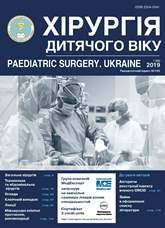Video-assisted lung lobe resections
DOI:
https://doi.org/10.15574/PS.2019.62.43Keywords:
VATS-lobectomy, resection of the lobe, video-assisted resectionAbstract
Video-assisted thoracoscopic (VATS) lobectomy is performed using endoscopic instruments based on stapler technique and general surgical elements. Priority is given to performing typical resections with separate treatment of elements of the root of the lobe (arteries, veins, bronchus).
Materials and methods. Over the past 5 years (from 2014 to 2018), in the department of thoracic surgery and invasive diagnostic methods at the State Institution «National Institute of phthisiology and pulmonology named after F.G. Yanovsky NAMS of Ukraine» 36 VATS-resections of the lung lobe were performed. All 36 (100.0%) VATS resections were performed using bronchial intubation of the contralateral lung, with minithoracotomic incision of no more than 8 cm. The treatment of the elements of the root of the lobe was performed using endoscopic stapling device based on stapler technique, and mechanical phrenicotripsy was performed intraoperatively.
Results. Intraoperative complications were diagnosed in 2 (5.6%) patients. In 1 (2.8%) patient a conversion was made to open thoracotomy with stopping the bleeding. The overall ratio of postoperative complications was 5 (13.9%) observations. The average duration of resection surgeries was 188.4±73.6 minutes; and the average intraoperative blood loss was 86.1±154.1 ml. The average duration of treatment in the postoperative period was 29.2±14.1 days.
Conclusions. VATS resection of the lung lobe is a non-traumatic and promising treatment method that provides anatomical dissection of elements of the lung lobe root. It can be considered as an alternative to open lobectomy. The widespread use of this method is impeded by the pronounced fibrosis of the lung root and adhesion processes due to the prolonged inflammatory process and medications treatment, as well as the cost of endoscopic instruments.
References
Chung JH et al. (2015, Jun). Uniportal video-assisted thoracoscopic lobectomy: an alternative to conventional thoracoscopic lobectomy in lung cancer surgery? Interact Cardiovasc Thorac Surg. 20(6):813–819. https://doi.org/10.1093/icvts/ivv034; PMid:25736285
Ismail NA, Elsaegh M, Dunning J. (2015). Novel Techniques in Video-assisted Thoracic Surgery (VATS) Lobectomy. Surg Technol Int. 26:206–209. Review. PMID: 26055011.
McElnay P et al. (2014). Adopting a standardized anterior approach significantly increases video-assisted thoracoscopic surgery lobectomy rates. Eur J Cardiothorac Surg. 1:100105. https://doi.org/10.1093/ejcts/ezt561; PMid:24335265. Epub 2013 Dec 11.
Melfi FM, Fanucchi O, Davini F, Mussi A. (2014). VATS-based approach for robotic lobectomy. Thorac Surg Clin. 2:143–149. https://doi.org/10.1016/j.thorsurg.2014.02.003; PMid:24780417
Mercedes de la Torre et al. (2016). Uniportal VATS lobectomy. Minerva Chir. 71(1):46–60. Epub 2015 Nov 24. Review. PubMed PMID: 26606690.
Mollberg NM, Mulligan MS. (2014). Video-assisted thoracoscopic (VATS) lobectomy after induction therapy. Thorac Surg Clin. 4:465–470. https://doi.org/10.1016/j.thorsurg.2014.07.013; PMid:25441140
Downloads
Issue
Section
License
The policy of the Journal “PAEDIATRIC SURGERY. UKRAINE” is compatible with the vast majority of funders' of open access and self-archiving policies. The journal provides immediate open access route being convinced that everyone – not only scientists - can benefit from research results, and publishes articles exclusively under open access distribution, with a Creative Commons Attribution-Noncommercial 4.0 international license(СС BY-NC).
Authors transfer the copyright to the Journal “PAEDIATRIC SURGERY.UKRAINE” when the manuscript is accepted for publication. Authors declare that this manuscript has not been published nor is under simultaneous consideration for publication elsewhere. After publication, the articles become freely available on-line to the public.
Readers have the right to use, distribute, and reproduce articles in any medium, provided the articles and the journal are properly cited.
The use of published materials for commercial purposes is strongly prohibited.

